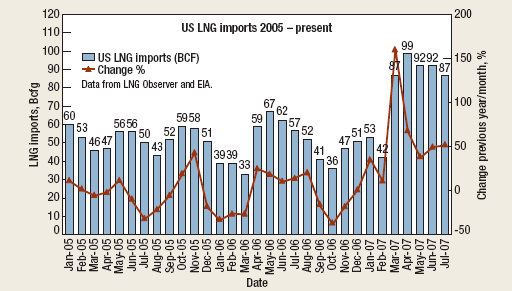What's new in exploration
Will LNG imports hurt US natural gas exploration? The price of natural gas in the US (Henry Hub) dropped 30% between early June and late July 2007, from $7.89 to $5.56/MMbtu ($8.10-5.71/Mcf). From March to July, US imports of LNG surged to record levels, averaging 73% higher per month than the same period in 2006. Are the vast reserves of previously stranded gas beginning to enter the US? And will LNG imports hurt domestic gas E&P? Probably not in the near term, but it is important to understand the factors affecting the recent gas price downturn. The fundamental gap between indigenous North American gas supply and demand is undeniable (“The impending US gas supply crisis: Why prices will increase,” World Oil, June 2007), but prices are based on a short-term supply assessment that generally consists only of the current and upcoming demand seasons. A mild 2006-2007 winter and an exceptionally cool 2007 summer in the US have resulted in record amounts of gas in storage because of reduced energy consumption for heating and cooling. There is ample supply through the winter of 2007-2008 based on current market assumptions, so the price has decreased accordingly. LNG will play a major role in supplying the US with gas in the future but, for the present, LNG will remain a marginal supply source. Unlike Europe and Asia, the US has substantial reserves of both gas and coal to meet a base level of power demand for many years into the future. In 2006, LNG accounted for less than 3% of total US natural gas consumption. Other industrialized nations are ahead in building re-gasification import facilities. LNG production is the limiting factor in supply. While foreign producers have abundant gas reserves, construction of liquefaction facilities lags far behind present demand. In addition to construction delays, liquefaction projects have experienced significant operational, design and efficiency problems. Competition for supply is, therefore, high. Markets that have limited indigenous gas and coal supplies, such as Europe and Asia, are willing to pay for long-term, relatively high-priced LNG contracts, while markets that have energy options, like the US, are not.
For US gas distribution companies, LNG is just another gas source and, therefore, they avoid long-term contracts. They buy LNG on spot contracts when it is available-in other words, when demand is relaxed from countries that have long-term contracts. Europe had an exceptionally mild winter in 2006-2007 resulting in an oversupply of LNG. The US bought much of this surplus, accounting for the high levels imported from March to July of this year. Five new LNG terminal projects are being built on the US Gulf Coast, and 13 terminals are scheduled to be completed there by 2010. Many of these facilities will be seriously undersupplied, with only about 25% utilization, because they lack long-term supply contracts (LNG Observer, July-September, 2007). Only the Golden Pass LNG Terminal near Sabine, Texas has a supply contract. The rest will require access to gas storage that does not now exist, or else they may never see more than an occasional spot cargo (Platt’s Gas Market Report, June 29, 2007). The 50 Bcf Mobile Bay Storage Facility will be operating in 2008, but already 60% of its capacity has been sold to conventional gas producers. It is notable that Anadarko sold its Bear Head LNG Terminal in Nova Scotia in 2006, because a secure, acceptable supply contract could not be identified; the buyer, Venture Energy, has yet to proceed with construction for the same reason. The US imports an average of 310 Bcf/month of gas from Canada. The increase in imported LNG in 2007 was largely at the expense of gas usually imported from Canada. While Canadian production declined somewhat in 2007, average monthly consumption increased 11% during May 2006-May 2007 compared to the previous 12-month period. During December 2006-May 2007 its consumption averaged 19% higher than during December 2005-May 2006. Some of the increase probably went for tar sand production and upgrading. The recent increase in US imported LNG probably does not signal a new era. It was an anomaly that resulted from a combination of decreased supply from Canada along with an oversupply of LNG in Europe due to the weather. If reduced Canadian supply persists, alternate gas sources will become critical, since the US cannot rely on abnormal weather elsewhere in the world to make LNG supplies available. It is likely that coal (and, in the longer-term, coal-to-gas and nuclear) may be a more attractive power generation source than LNG. This does not minimize the future role of LNG in the US. Longer term, gas prices will increase because the margin of surplus is small. Gas explorers should capitalize on the lower rig and service rates produced by low prices to consolidate their positions, and be ready to drill when gas prices inevitably increase again.
Arthur Berman is a geological consultant specializing in petroleum geology, seismic interpretation and database design and management. He has over 20 years’ working for major oil companies and was editor of the Houston Geological Society’s Bulletin. He earned an MS in geology from the Colorado School of Mines.
|
||||||||
- Prices and governmental policies combine to stymie Canadian upstream growth (February 2024)
- U.S. producing gas wells increase despite low prices (February 2024)
- U.S. drilling: More of the same expected (February 2024)
- U.S. oil and natural gas production hits record highs (February 2024)
- Quantum computing and subsurface prediction (January 2024)
- U.S. upstream muddles along, with an eye toward 2024 (September 2023)
- Applying ultra-deep LWD resistivity technology successfully in a SAGD operation (May 2019)
- Adoption of wireless intelligent completions advances (May 2019)
- Majors double down as takeaway crunch eases (April 2019)
- What’s new in well logging and formation evaluation (April 2019)
- Qualification of a 20,000-psi subsea BOP: A collaborative approach (February 2019)
- ConocoPhillips’ Greg Leveille sees rapid trajectory of technical advancement continuing (February 2019)





